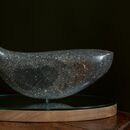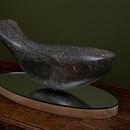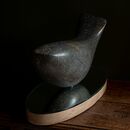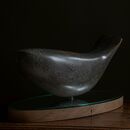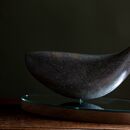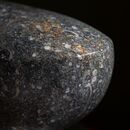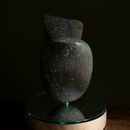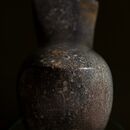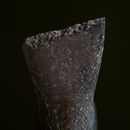whale II
My second whale inspired by the beauty of the stone and this time worked in green Purbeck marble. The texture of the tiny shells and the blues, greys and greens echo the deep oceans and the barnacled whales that swim in their depths. Taking inspiration from Brancusi I again sought to capture the essence of the mammal, its gracefulness and its heftiness in as simple a shape as possible with the mirror making reference to the water. Like many of my pieces in this themed exhibition the form can be interpreted in different ways.
Material; Purbeck marble
Dimensions HWD; 34x60x25 cm
Feb 2023
SOLD
Purbeck marble is in fact a limestone formed 140 to 145 million years ago (the Early Cretaceous period) and called a “marble” because it can be worked to a highly polished finish. Its formed entirely of river snail shells (Viviparus) that collected in lagoonal beds on the Jurassic coast of Britain covering large parts of the Purbeck peninsula to a depth of just over 1m thick. The River Snail as a species is still around today! Over millions of years the shells have fossilized (absorbed minerals) and turned to stone.
The Romans quarried and worked the stone for its colour and high polish and its been used in virtually every Cathedral in Southern England as a decorative stone. It was also used in The Kings table used by Henry VIII.
Material; Purbeck marble
Dimensions HWD; 34x60x25 cm
Feb 2023
SOLD
Purbeck marble is in fact a limestone formed 140 to 145 million years ago (the Early Cretaceous period) and called a “marble” because it can be worked to a highly polished finish. Its formed entirely of river snail shells (Viviparus) that collected in lagoonal beds on the Jurassic coast of Britain covering large parts of the Purbeck peninsula to a depth of just over 1m thick. The River Snail as a species is still around today! Over millions of years the shells have fossilized (absorbed minerals) and turned to stone.
The Romans quarried and worked the stone for its colour and high polish and its been used in virtually every Cathedral in Southern England as a decorative stone. It was also used in The Kings table used by Henry VIII.
